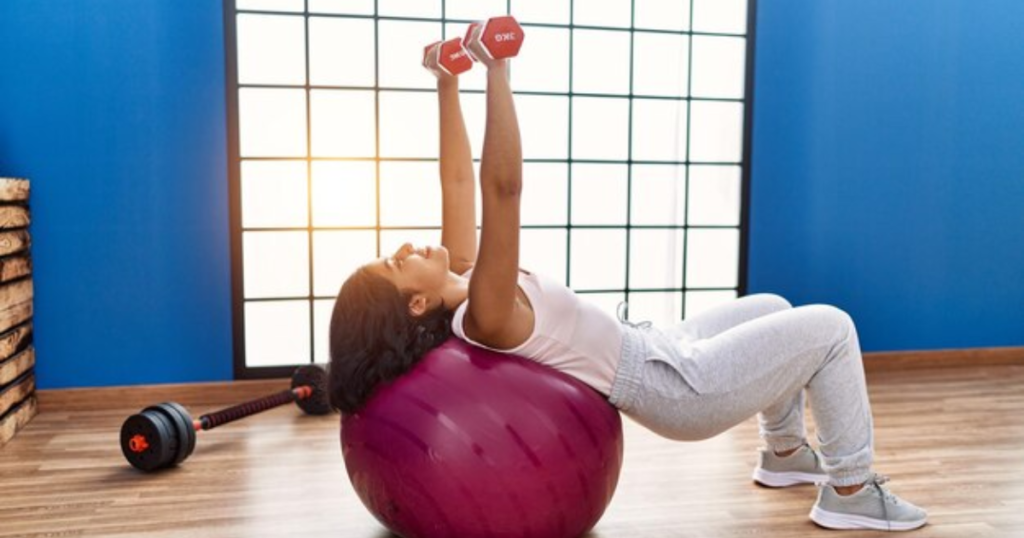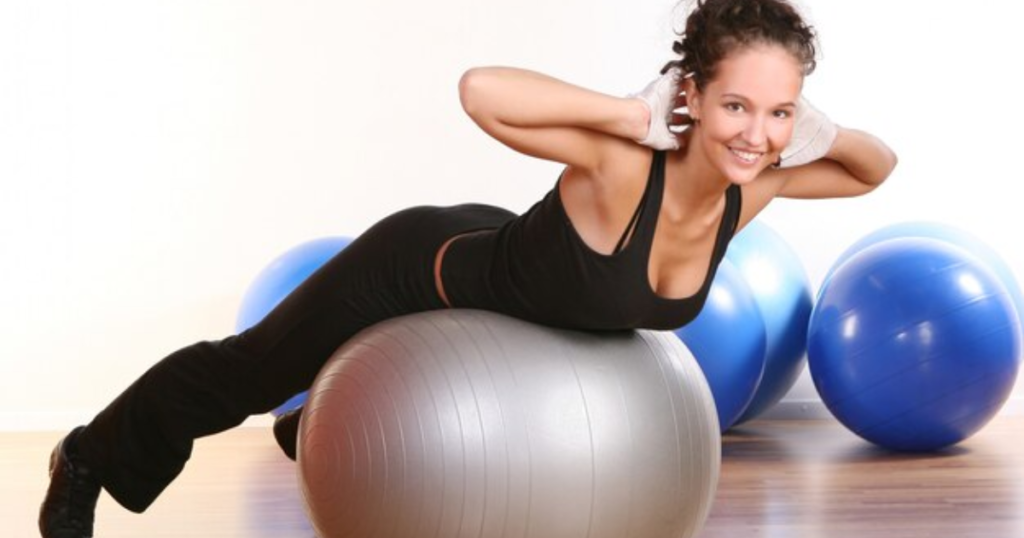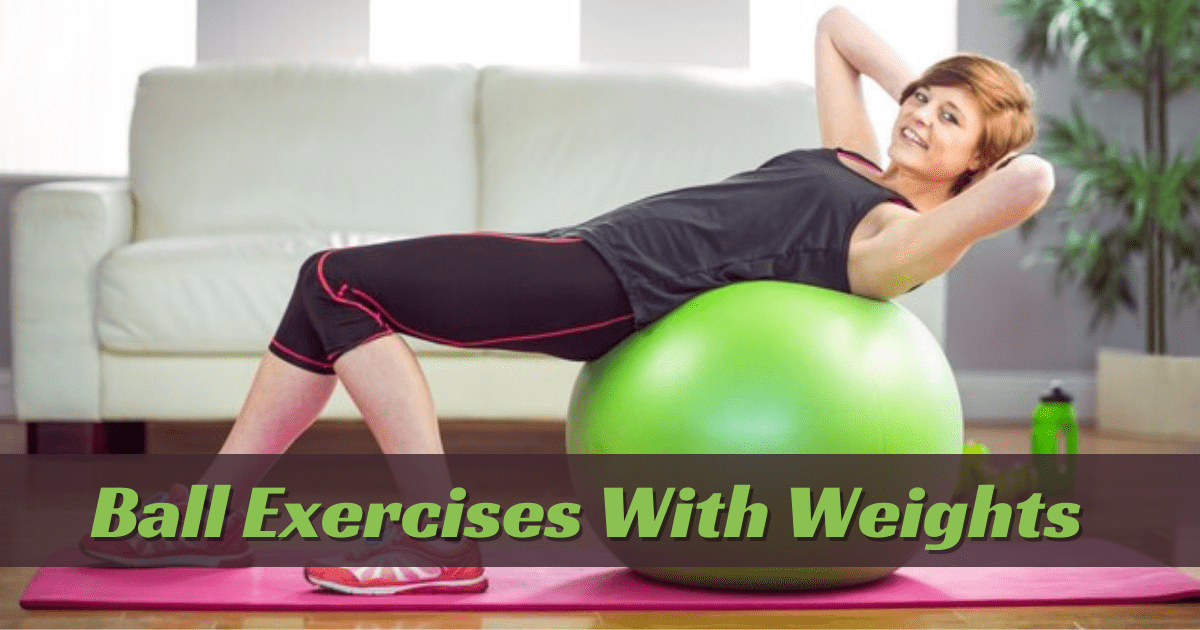In the realm of fitness, innovation and versatility are key. One such innovation that has gained immense popularity in recent years is ball exercises with weights. Combining the benefits of stability balls with the resistance provided by weights, these exercises offer a holistic approach to strength training. Let’s delve into the world of ball exercises with weights and explore how they can help you achieve your fitness goals.
Introduction to Ball Exercises with Weights
Ball exercises with weights combine stability and resistance training to create a comprehensive workout that targets multiple muscle groups, improves balance, coordination, and core strength. The use of a stability ball adds instability, challenging balance, while weights provide additional resistance to build strength and muscle tone. Key exercises include ball squats with dumbbells, stability ball chest press, Russian twists with weighted ball, and ball hamstring curls with weight plate.
Benefits of ball exercises with weights include enhanced core stability and strength, improved balance and coordination, increased muscle strength and endurance, and aiding in rehabilitation and injury prevention. Safety tips include choosing an appropriate weight, maintaining control throughout movements, paying attention to body alignment, and always warming up before starting a workout. Gradually increasing intensity and difficulty as you progress can further challenge your muscles and improve your overall fitness level.
Benefits of Incorporating Weights into Ball Exercises
Incorporating weights into ball exercises has various advantages:
- Increased Muscle Activation: Adding weights to ball workouts increases resistance, which leads to more muscle activation. This increases strength and muscular mass more effectively than bodyweight exercises alone.
- Improved Strength: Lifting weights forces your muscles to work harder, which leads to gradual strength gains. This is especially useful for exercises that work large muscle groups such as the chest, back, legs, and shoulders.
- Enhanced Stability and Balance: Balancing on a stability ball while holding weights necessitates coordination and stability. This engages the core and stabilizer muscles, resulting in improved balance and proprioception.
- Functional Strength: Many ball exercises with weights simulate real-life movements, making them extremely practical. This can lead to enhanced performance in daily activities and sports.
- Core Engagement: The instability of the ball, along with the added resistance of the weights, causes the core muscles to work harder to maintain stability and perfect form. This results in stronger, more developed abdominal muscles.
- Calorie Burn: Adding weights to ball movements improves the intensity of the activity, resulting in a higher calorie burn. This can help with weight management and fat loss goals.
- diversity and advancement: Including weights in ball exercises adds diversity to your workout regimen and allows for advancement as you gain strength and endurance. To keep your muscles challenged, gradually increase the weight or repetitions.
general, combining weight and ball workouts is a thorough and effective strategy to increase strength, stability, and general fitness.
Choosing the Right Weight and Ball Size
To ensure a safe and effective workout when incorporating ball exercises with weights, start with a weight that allows proper form and control, challenges muscles without compromising stability and alignment. Start with lighter weights and gradually increase resistance as you become stronger. Consider your fitness goals and specific exercises when selecting the weight.
Choose a stability ball size that corresponds to your height for proper alignment and comfort. Inflate the ball according to manufacturer’s instructions. Prioritize safety when selecting weights and using the stability ball, maintain proper form and alignment, and consult with a healthcare professional if you have pre-existing medical conditions. Regularly reassess equipment choices and adjust as needed.
7 Best Ball Exercises with Weights:
1. Ball Squat Press
The ball squat press is a dynamic compound exercise that works the lower, core, and upper body muscles simultaneously. To do this exercise:
- Start by holding a weighted ball at chest height.
- Lower into a squat while pressing the ball overhead.
- Return to the starting location and repeat the desired number of times.

2. Russian Twist with Weighted Ball
The Russian twist with a weighted ball is an excellent workout for strengthening the obliques and increasing rotational stability. To successfully complete the activity, follow these steps:
- Sit on the floor, knees bent and feet elevated, with a weighted ball in front of you.
- Lean back slightly to engage your core, then twist your torso to one side, bringing the ball to the floor.
- Return to the center and perform the same action on the opposing side.
- Continue to alternate sides for the required amount of repetitions.

3. Ball Bridge with Chest Press
The ball bridge and chest press are an effective combined workout that works the chest, shoulders, triceps, and core muscles. Here’s how to do it correctly.
- Lie on your back, upper back resting on a stability ball, knees bent at a 90-degree angle.
- Hold a weighted ball in each hand and extend your arms to the ceiling.
- Use your core and glutes to lift your hips off the ground and into a bridge position, while pressing the balls towards the ceiling.
- Lower your hips back to the beginning position, then repeat for the desired amount of reps.

4. Overhead Ball Lunges
Overhead ball lunges are a useful unilateral exercise that tests balance, stability, and lower-body strength. To do this exercise:
- Begin by holding a weighted ball aloft with both hands.
- Take a big step forward into a lunge, lowering your back knee to the ground.
- To return to the starting posture, keep your core engaged and your torso erect while pushing through the heel.
- Repeat with the opposite leg, alternating sides for the appropriate amount of repetitions.

5. Ball Deadlift
The ball deadlift is a modification of the standard deadlift that introduces instability and engages additional stabilizing muscles. Follow these instructions to complete the exercise correctly:
- Standing with your feet hip-width apart, hold a weighted ball in front of you.
- Hinge at the hips and slightly bend your knees while dropping the ball to the ground.
- To return to the starting posture, keep your spine neutral and your core engaged while pushing through your heels.
- Repeat for the required number of times, keeping proper form throughout the action.

6. Ball Slam
Ball slams are a dynamic, full-body exercise that can help you release pent-up energy while also increasing explosive power and strength. To do a ball slam:
- Standing with your feet shoulder-width apart, hold a weighted ball overhead.
- Use your core to smack the ball onto the ground straight in front of you.
- Catch the ball on the rebound and repeat for the appropriate number of reps.

7. Ball Plank with Alternating Arm Lift
The ball plank with alternating arm lift is a more advanced version of the standard plank exercise that includes an element of instability. To complete the workout effectively, take the following steps:
- Begin in a plank position, hands resting on a stability ball and feet hip-width apart.
- Maintain a straight line from the head to the heels by using your core and glutes.
- Lift one arm off the ball and extend it forward while your hips remain solid.
- Return to the beginning position, then repeat with the opposing arm.
- Continue alternating arms for the required number of repetitions, concentrating on maintaining perfect form.

Upper Body Exercises
Dumbbell Chest Press on Stability Ball
The Dumbbell Chest Press on Stability Ball is a dynamic workout that works the chest, shoulders, and triceps while also activating the core and increasing balance and stability. By completing this exercise on a stability ball, you create an element of instability, necessitating increased activation of stabilizing muscles throughout the body.
Instructions:
- Sit on the stability ball with dumbbells in hand, positioned at chest height.
- Walk your feet forward, rolling down until your head and shoulders are supported by the ball.
- Engage your core and press the dumbbells upward until your arms are fully extended.
- Lower the dumbbells with control, keeping elbows slightly below shoulder level.
Overhead Triceps Extension
The overhead triceps extension is a fundamental strength training exercise that works the triceps muscles on the back of the upper arm. This exercise is primarily designed to increase triceps strength and muscle definition while also activating the shoulders and core for stability.
Instructions:
- Sit on the stability ball, holding a dumbbell with both hands overhead.
- Keep your elbows close to your ears as you lower the dumbbell behind your head.
- Extend your arms upward, returning to the starting position.
- Repeat for the desired number of repetitions.
Bicep Curls
Bicep curls are essential strength-training movements that work the biceps brachii muscle, which is positioned on the front of the upper arm. These are popular workouts for increasing arm strength, size, and definition. Here’s an introduction to the bicep curl:
Instructions:
- Sit tall on the stability ball, holding dumbbells at arm’s length by your sides.
- Keeping your elbows close to your body, curl the dumbbells toward your shoulders.
- Lower the dumbbells with control, fully extending your arms.
- Repeat for the desired number of repetitions.
Shoulder Press
Shoulder press is a basic strength training exercise that works the deltoid muscles in the shoulders, as well as the triceps and upper back. It can be done with a variety of equipment, including dumbbells, barbells, kettlebells, and resistance bands. Here is an introduction to the shoulder press workout.
Instructions:
- Sit on the stability ball, holding dumbbells at shoulder height with palms facing forward.
- Press the dumbbells upward until your arms are fully extended.
- Lower the dumbbells back to shoulder height with control.
- Repeat for the desired number of repetitions.
Lower Body Exercises
Squats with Weights on Stability Ball
Squats with weights on a stability ball are a dynamic and difficult variant on the standard squat exercise. The stability ball engages additional muscles to keep your body stable during the activity, while the added weights provide resistance to build and tone your lower body muscles. Here’s an introduction to squats with weights and a stability ball:
Instructions:
- Place a stability ball between a wall and your lower back.
- Hold a dumbbell in each hand at shoulder height.
- Lower into a squat position, keeping your back against the ball and knees aligned with your toes.
- Push through your heels to return to the starting position.
Lunges with Dumbbells
Lunges with dumbbells are a powerful strength training exercise that works numerous muscular groups at once, including the quadriceps, hamstrings, glutes, and calves. Here’s an introduction to dumbbell lunges, along with instructions on how to do them correctly:
Instructions:
- Stand with feet hip-width apart, holding dumbbells at your sides.
- Take a step backward with one foot, lowering your back knee toward the ground.
- Press through your front heel to return to the starting position.
- Alternate legs and repeat for the desired number of repetitions.
Deadlifts
Deadlifts are a fundamental compound exercise that works numerous muscle groups at once, making them an essential component of strength training regimens. Here is an introduction to deadlifts.
Instructions:
- Stand with feet hip-width apart, holding dumbbells in front of thighs.
- Hinge at the hips, lowering the dumbbells toward the ground while keeping your back straight.
- Engage your hamstrings and glutes to return to a standing position.
- Repeat for the desired number of repetitions.
Core Strengthening Exercises
Russian Twists
Russian twists are a dynamic core workout that works the oblique, abdominal, and hip flexor muscles. They incorporate a twisting action that works the muscles in the abdomen while also testing balance and stability. This is an introduction to Russian twists.
Instructions:
- Sit on the stability ball with feet planted firmly on the ground.
- Lean back slightly, keeping your back straight and core engaged.
- Hold a dumbbell with both hands and rotate your torso to the right, then to the left.
- Continue alternating sides for the desired number of repetitions.
Weighted Sit-Ups
Weighted sit-ups are a dynamic core strengthening exercise that uses additional weight to increase the intensity of the activity. This exercise stimulates the abdominal muscles, specifically the rectus abdominis, obliques, and hip flexors, as well as the lower back and torso stabilizing muscles.
Instructions:
- Lie back on the stability ball with feet planted firmly on the ground.
- Hold a dumbbell against your chest.
- Engage your core and lift your torso toward your thighs.
- Lower back down with control and repeat for the desired number of repetitions.
Plank with Shoulder Taps
The plank with shoulder taps is a dynamic variation of the standard plank exercise that challenges your core muscles in rotation and stability while also activating your shoulders, arms, and back. Here’s an introduction to the plank with shoulder taps:
Instructions:
- Assume a plank position with hands on the stability ball and feet hip-width apart.
- Keeping your core engaged and hips stable, tap your right hand to your left shoulder.
- Return to the starting position and repeat on the opposite side.
- Continue alternating shoulder taps for the desired number of repetitions.
Stability Ball Rollouts
Stability ball rollouts are a dynamic core workout that works the abdominals, obliques, lower back, and other stabilizers. This workout involves rolling the stability ball away from your body while keeping control and stability in your core. This is an introduction to stability ball rollouts.
Instructions:
- Kneel on the ground with a stability ball in front of you.
- Place your forearms on the ball and engage your core.
- Roll the ball forward, extending your arms until your body forms a straight line.
- Roll the ball back to the starting position with control.
Incorporating Weighted Ball Exercises into a Routine
Incorporating weighted ball exercises into your routine can add variety, challenge, and effectiveness to your workout regimen. Below is a sample routine that combines weighted ball exercises with other strength and cardio exercises for a well-rounded workout:
Warm-up:
- 5-10 minutes of light cardio (e.g., jogging, jumping jacks, or cycling)
- Dynamic stretches for the upper and lower body (arm circles, leg swings, torso twists)
Main Workout:
1. Weighted Ball Squats:
- Hold a weighted ball at chest height.
- Perform three sets of 12 to 15 repetitions.
- Rest for 60 seconds between each set.
2. Push-ups with Weighted Ball Roll:
- Push-up with one hand and a weighted ball underneath.
- Roll the ball to the other hand, then repeat.
- Complete three sets of ten to twelve repetitions per side.
- Rest for 60 seconds between each set.
3. Russian Twists with Weighted Ball:
- Sit on the floor, knees bent and feet lifted, clutching a weighted ball.
- Twist your torso to one side and place the ball beside your hip.
- Perform three sets of 15-20 reps on each side, alternating.
- Rest 45 seconds between sets.
4. Weighted Ball Lunges:
- Hold a weighted ball at chest height.
- Step forward into a lunge with one leg, lowering the ball to the floor.
- Return to the starting position, then switch legs.
- Complete three sets of ten to twelve reps per leg.
- Rest for 60 seconds between each set.
5. Medicine Ball Slams:
- Lift a weighted ball aloft using both hands.
- Slam the ball into the ground as hard as possible.
- Catch the ball on the bounce, then repeat.
- Perform three sets of 12 to 15 repetitions.
- Rest for 60 seconds between each set.
6. Plank with Weighted Ball Roll:
- Get into a plank position with your hands on the ground and your feet hip-width apart.
- Place a weighted ball in one hand and roll it to the other.
- Continue alternating sides for three sets of ten to twelve reps each.
- Rest 45 seconds between sets.
Cool-down:
- 5-10 minutes of gentle cardio (such as walking or riding)
- Static stretches for key muscular groups (hamstrings, quadriceps, chest, shoulders, and back).
Precautions and Tips for Safety
When incorporating ball exercises with weights into your workout routine, it’s crucial to prioritize safety to prevent injuries and ensure a productive session. Here are some precautions and tips to keep in mind:
1. Proper Form:
- Maintain appropriate form for injury prevention.
- Focus on stability, alignment, and controlled motions.
- Engage core muscles for stability.
- Avoid arching or rounding back.
2. Choose Appropriate Weights:
- Choose suitable weights for fitness level.
- Start with lighter weights gradually increase resistance.
- Avoid heavy weights to maintain form and reduce injury risk.
3. Stability Ball Safety:
- Inflate ball properly and maintain condition.
- Use non-slip mat or stable surface for safety.
- Check manufacturer’s guidelines for weight limits and usage recommendations.
4. Warm-up:
- Prepare muscles and joints for exercise.
- Incorporate dynamic stretches and light cardio.
- Increase blood flow and body warmth.
5. Progress Gradually:
- Start with basic exercises.
- Gradually increase intensity, duration, resistance.
- Avoid overexertion or injury.
6. Listen to Your Body:
- Pay attention to body signals.
- Avoid excessive pushing.
- Stop exercise if sharp pain occurs.
- Seek guidance from fitness professional or healthcare provider.
7. Hydration and Rest:
- Stay hydrated before, during, and after workouts.
- Allow adequate rest and recovery time between sessions.
8. Seek Professional Guidance:
- Seek guidance from certified personal trainers or fitness instructors.
- Consult with healthcare provider for pre-existing medical conditions or injuries.
By following these precautions and tips for safety, you can minimize the risk of injury and enjoy the benefits of ball exercises with weights while achieving your fitness goals effectively.
Read More: Top 9 Lat Workouts with Dumbbells
Conclusion
Ball exercises with weights offer a dynamic and effective way to strengthen your entire body while improving balance, stability, and coordination. By combining the benefits of stability balls with the resistance provided by weights, you can elevate your workouts and achieve your fitness goals more efficiently. Whether you’re a beginner or an experienced gym-goer, incorporating weighted ball exercises into your routine can enhance your overall strength and performance.
Frequently Asked Questions
What are ball exercises using weights?
Ball exercises with weights are workouts in which you utilize a stability ball and weights to develop your muscles. It’s similar to conventional exercises, but with the added obstacle of balancing on a ball.
Are ball workouts with weights suitable for children?
It depends on the child’s age and level of fitness. Some ball exercises with modest weights can be safe and enjoyable for children, but it’s always a good idea to consult a parent or a fitness instructor.
What muscles do ball workouts with weights target?
Ball workouts with weights can engage a variety of muscles! They can assist build your core muscles (such your abdomen and back), arms, legs, and even your balance!
Can ball workouts with weights help you lose weight?
Ball workouts with weights can absolutely be included in a weight loss strategy! They help you gain muscle, which boosts your metabolism and allows you to burn more calories throughout the day. However, remember that eating properly and engaging in other forms of physical activity are also vital!
How can I begin performing ball exercises with weights?
It is easy to get started! There are numerous videos available online that demonstrate various exercises that may be performed using a stability ball and weights. Begin with lesser weights and simpler exercises, gradually progressing to more difficult ones as you gain strength. Don’t forget to have fun as you exercise!









Leave a Reply